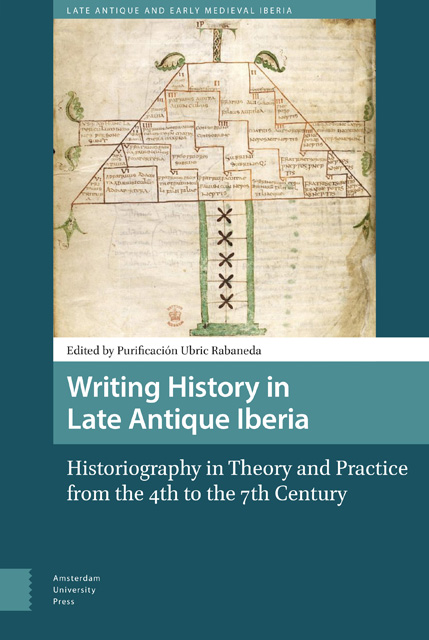 Writing History in Late Antique Iberia
Writing History in Late Antique Iberia Book contents
- Frontmatter
- Table of Contents
- 1 Writing History in Late Antique Iberia: Theory and Praxis
- 2 Para qué sirve la Historia : Principios teóricos de la historiografía hispana tardoantigua
- 3 From Christian Historiography to the Emergence of National Histories : Spanish Historiography between Romans and Visigoths
- 4 Orosius: An Iberian Patriot’s History of Rome
- 5 Orosius, Barbarians, and the Christian Success Story
- 6 Prophecies and Omens of the Fall of the Roman Empire in the Chronicle of Hydatius of Lemica
- 7 La dimensión política de los historiadores del reino visigodo de Toledo
- 8 The Definitions and Uses of Historia in Isidore of Seville
- 9 Bishops and Their Biographers : The Praxis of History Writing in Visigothic Iberia
- 10 Local Powers and Construction of the Past in the Visigothic Kingdom of Hispania
- 11 The Contemplation of the Past in the Libellus Precum of Faustinus (and Marcellinus)
- 12 Orthodoxy and Heterodoxy : The Historiography of Hispania in Late Antiquity
- 13 Expulsados de la Historia : El argumento histórico en la polémica antijudía hispana (siglos IV-VII)
- 14 Consideraciones sobre la temporalidad en las Vitae Sanctorum visigóticas
- 15 The Image of Leovigild as Arian Monarch in the ‘Vitas Patrum Emeritensium’ : From Historical Reality to Hagiographical Deformation
- Index
15 - The Image of Leovigild as Arian Monarch in the ‘Vitas Patrum Emeritensium’ : From Historical Reality to Hagiographical Deformation
Published online by Cambridge University Press: 18 April 2023
- Frontmatter
- Table of Contents
- 1 Writing History in Late Antique Iberia: Theory and Praxis
- 2 Para qué sirve la Historia : Principios teóricos de la historiografía hispana tardoantigua
- 3 From Christian Historiography to the Emergence of National Histories : Spanish Historiography between Romans and Visigoths
- 4 Orosius: An Iberian Patriot’s History of Rome
- 5 Orosius, Barbarians, and the Christian Success Story
- 6 Prophecies and Omens of the Fall of the Roman Empire in the Chronicle of Hydatius of Lemica
- 7 La dimensión política de los historiadores del reino visigodo de Toledo
- 8 The Definitions and Uses of Historia in Isidore of Seville
- 9 Bishops and Their Biographers : The Praxis of History Writing in Visigothic Iberia
- 10 Local Powers and Construction of the Past in the Visigothic Kingdom of Hispania
- 11 The Contemplation of the Past in the Libellus Precum of Faustinus (and Marcellinus)
- 12 Orthodoxy and Heterodoxy : The Historiography of Hispania in Late Antiquity
- 13 Expulsados de la Historia : El argumento histórico en la polémica antijudía hispana (siglos IV-VII)
- 14 Consideraciones sobre la temporalidad en las Vitae Sanctorum visigóticas
- 15 The Image of Leovigild as Arian Monarch in the ‘Vitas Patrum Emeritensium’ : From Historical Reality to Hagiographical Deformation
- Index
Summary
Abstract
This chater presents a reinterpretation of the confrontation between Bishop Masona and King Leovigild narrated in the Vitas Patrum Emeritensium . Trying to elucidate what historical truth there may be behind this hagiographic text, this event is compared with the information we have through other sources and more recent historiography. The image offered by this work of a persecuting Leovigild and of Masona, as a victim of that persecution is presented as a continuation of the martyr literature based on the opposition of the Christian ‘martyr’ to the tyrannical emperor and ‘persecutor’. In this way, Leovigild, far from being the evil king portrayed in the Lives, appears as a monarch whose religious policy was characterised by tolerance.
Keywords: martyr, persecutor, Arianism, history, hagiography, Vitas Patrum Emeritensium
Pedro Castillo Maldonado began his essay on ‘Catholics and Arians in Visigothic Spain: The Conformation of a Unified System of Domination’ by referring to the historical painting by José Martí y Monsó, found in the Spanish Senate, which praises Reccared’s conversion to Nicene Catholicism in 589: ‘Due to its iconographic imagery, which was a bit outmoded, quite static and of dubious artistic quality, the spectator gets the impression of watching a historical event, the Third Council of Toledo, solemn and peaceful’. We prefer to remember the work by Antonio Muñoz Degrain on the same subject, also commissioned by the Senate in 1888, and, thanks to its success, according to Tomás Pérez Veo, became the ‘true’ image of the historical event, even displacing that of Martí y Monsó, the traditional painting until that time. However, as Pérez Viejo himself recalls, ‘Reccared’s presence in the symbolic buildings of the State, temples of the nation, was not limited to the Senate. The Visigothic monarch is among those who appear on the decorated ceiling of the sessions hall of the Congress (work of Carlos Luis de Ribera), in the company of – to make the reasons for his presence clear – Saint Isidore of Seville’. Somehow, each of them tried to illustrate the idea of the official historian of the period, Modesto Lafuente, considered to be the most important figure of the liberal and conservative Spanish historiography.
- Type
- Chapter
- Information
- Writing History in Late Antique IberiaHistoriography in Theory and Practice from the 4th to the 7th Century, pp. 293 - 306Publisher: Amsterdam University PressPrint publication year: 2022


